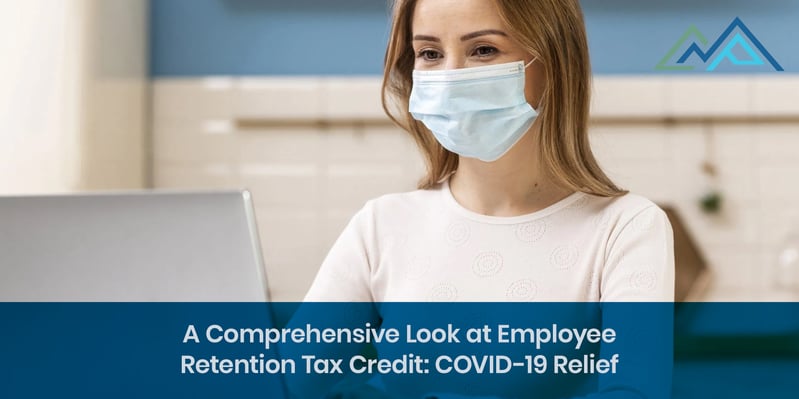The COVID-19 pandemic continues to impact businesses and their employees in a myriad of ways. Employers must take advantage of every tool available to them to protect themselves and the people who work for them.
At CMP, we work with employers to ensure that they take every tax credit that is due to them. The CARES Act, which was enacted in March of 2020, introduced the employee retention tax credit. The CARES Act allows employers to reduce their payroll tax burden by deducting a percentage of wages paid to employees from the employer’s payroll liabilities. Additional legislation has expanded the credit. Here's what you need to know:

What is the Employee Retention Tax Credit?
The Employee Retention Tax Credit is a credit provided for eligible employers against certain employment taxes. The employer receives a credit for 50% of qualified wages paid after March 12, 2020, and before January 1, 2021.
If you qualify, the credit may be claimed on your payroll tax return, usually Form 941. If you prefer, you can reduce the amount of your tax deposits during the quarter, and reconcile the reduction on your payroll tax return. Since the credit applies to wages that have already been paid, some companies may be able to request an advance deposit from the IRS.
The purpose of the employee retention credit is to encourage employers to continue to pay their employees even if they are not able to work during the pandemic. It was included as part of the CARES Act as a way of minimizing the economic impact of COVID-19. If you have continued to pay employees and you are eligible, you may reduce your tax burden by claiming the credit.
Employee Retention Credit Eligibility
Is your business qualified to receive the employee retention credit? Here are the criteria to use to determine whether you are eligible to take the credit.
- You must operate a trade or business under IRS definitions, which indicate that a business qualifies if its primary purpose is to earn a profit. (Note: this does not exclude nonprofit entities, who may still earn a profit but are limited in what they can do with the profits they earn.)
- Your business operations were "fully or partially suspended during any calendar quarter in 2020 due to orders from an appropriate governmental authority limiting commerce, travel, or group meetings (for commercial, social, religious, or other purposes) due to COVID-19." OR
- Your business "Experienced a significant decline in gross receipts during the calendar quarter."
We should clarify what qualifies as a "significant decline in gross receipts." According to the IRS, businesses that had gross receipts in any quarter in 2020 that were less than 50% of their gross receipts in the same quarter of 2019, have experienced a significant decline. At the other end of the spectrum, a business is considered to be out of a significant decline if the receipts are 80% or more of the gross receipts from the same quarter of 2019.
There are no limitations or exclusions based on business size or the number of employees. If your business qualifies, you may take the credit. Federal, state, and local government entities are not eligible.
Employee Retention Credit Changes Under Infrastructure Investment and Jobs Act
On November 15, 2021, the Infrastructure Investment and Jobs Act was signed into law. Although this legislation had few provisions regarding the ERC, there were a few important changes. Most significantly, the ERC was terminated for wages paid after September 30, 2021, unless the business is qualified as an eligible recovery startup business. The credit was originally extended through the end of 2021 with the passing of the American Rescue Plan, but this most recent legislation will conclude the employee retention credit one quarter earlier for non-recovery startup businesses. Therefore, the ERC will be available to most businesses for wages paid before September 30, 2021, assuming they meet the qualifications above, which have not been modified.
Maximum Amount of the Employee Retention Credit Available to Eligible Employees
One of the questions we have frequently heard regarding the Employee Retention Tax Credit is whether the credit is capped at any point.
The employee retention credit is on a per-employee basis. According to the CARES Act, an employer who has experienced a significant decline in gross receipts as defined in the previous section may claim up to 50% of up to $10,000 of qualified wages per employee, which is given as a credit on an employer’s payroll taxes. Later in this article, we explain some changes to the retention tax credit as of 2021.
The IRS breaks down qualified wages into two broad categories based on the number of employees you have:
- For employers averaging more than 100 full-time employees, qualified wages are wages, including certain health care costs, paid to employees who were not providing services due to a suspension of operations or due to a decline in gross receipts. Employers in this category may count wages paid after March that "would have been paid for working an equivalent duration during the 30 days immediately preceding the period of economic hardship."
- For employers averaging 100 or fewer full-time employees in 2019, qualified wages are wages, including certain health care costs, paid to any employee during a suspension of services or a decline in gross receipts, regardless of whether its employees are providing services.
The difference in the law is to allow small employers to claim the credit even if they have remained in operation throughout the COVID-19 pandemic.
How is the Employee Retention Tax Credit Calculated?
Calculating the Employee Retention Tax Credit is simple. You start by determining whether your business is eligible for the credit by asking the following two questions:
- Was your business ordered to fully or partially shut down due to COVID-19 restrictions? For example, service providers such as hair salons were ordered to fully shut down. Restaurants were ordered to cease in-person dining but could still offer take-out or delivery, which would qualify as a partial shut-down.
- Did your business experience a significant decrease (50% or more) in gross receipts in 2020 over the same quarter in 2019? For example, if your business had $300,000 in gross receipts in the second quarter of 2019 and only $125,000 in gross receipts in the second quarter of 2020, you would qualify.
Once you have determined that your business is eligible for the employee retention tax credit, follow these steps to calculate the amount of your credit.
- If your business has more than 100 employees, calculate the qualified wages you paid in the eligible quarter to each employee not working as a result of COVID-19.
- If your business has fewer than 100 employees, calculate the qualified wages you paid in the eligible quarter to all employees, whether they were providing services or not.
Remember that qualified wages are capped at $10,000 per employee. You will need to calculate the credit on a per-employee basis. Multiply their qualified wages by 50% to determine the per-employee credit and then add the totals for all employees to determine your total employee retention credit. Later in this article, we will explain how the calculations have changed for the first two quarters of 2021.
How to Claim the Employee Retention Credit
There are three ways that eligible employers may receive the employee retention tax credit. Employers who normally deposit federal employment taxes on a monthly or semi-weekly basis may reduce their tax deposits by the amount of the credit they are due.
If your credit amount is larger than the amount of your deposit, you may request an advance credit for qualified wages paid by filing Form 7200. You can then use the refund you receive to pay additional wages to your employees, or any other business expenses. (There are no limitations on how businesses may use money refunded as a result of the tax credit.)
The third and final option is to wait for a refund when you file Form 941. If you have not reduced your deposits or if you have additional credits due, you will get a refund after you file the form. Please note that all Employee Retention Credits must be reconciled on the employer’s quarterly or annual payroll tax forms.
Can You Get PPP and the Employee Retention Credit?
The Paycheck Protection Program, or PPP, was also part of the CARES Act. PPP provided employers with small business loans to help them meet their payroll obligations during the COVID-19 pandemic. Many of our clients at CMP want to know if having taken out a PPP loan precludes them from claiming the Employee Retention Tax Credit.
The answer is no, although it wasn't always that way. Unlike the employee retention credit, which is refundable, PPP loans must be repaid. Under the CARES Act, employers could only claim the employee retention credit only if they had repaid their PPP loans.
With the passage of the Taxpayer Certainty and Disaster Tax Relief Act of 2020, employers who took advantage of the PPP loan program may still claim the tax credit for wages paid even if they took out a PPP loan. The IRS website explains the rules like this:
The eligible employer can claim the ERC on any qualified wages that are not counted as payroll costs in obtaining PPP loan forgiveness. Any wages that could count toward eligibility for the ERC or PPP loan forgiveness can be applied to either of these two programs, but not both.
Businesses that can claim both may want to consult with tax professionals to ensure that they are applying the qualified wages paid appropriately. If you received a PPP loan, you may claim the credit provided you have qualified wages that were not used to qualify for the PPP loan.
You should also know that if you were granted a Paycheck Protection Program loan that has since been forgiven, you may not claim the credit for wages that were paid with the PPP loan. It is your responsibility under the PPP loan program to track how you spent the loan money. If you paid additional qualifying wages that were not covered by the PPP loan, then you may use those wages to calculate the employee retention credit.
Employee Retention Credit Changes Under New Stimulus Plan
So far, we have focused on the initial intention of the ERC as it applies to your 2020 taxes. However, there is new legislation that expands your ability to claim the ERC for wages paid in 2020 even if you have not already done so while also expanding the employee retention credit for 2021.
The Consolidated Appropriations Act of 2021, also known as the CAA, makes several provisions to expand the amounts of, and employers' access to, employee retention tax credits.
The first change is that the CAA expands the ERC to the first two quarters of 2021. This means that if your business continues to be fully or partially shut down, or you experience a reduction in gross receipts from January 1, 2021, through June 30, 2021, you may be eligible for the credit.
The second change under the Consolidated Appropriations Act is an increase in the threshold for employers to claim the ERC for employees who are working. The original legislation allowed only businesses with 100 or fewer employees to claim a credit for employees who continued to work. The CAA increases the total number of employees to 500.
The third change affects the percentage of qualified wages paid that may be used to calculate the ERC. Under the Consolidated Appropriations Act, employers may claim up to 70% of $10,000 per quarter of qualified wages per employee. The maximum credit per employee for 2021 wages is $7,000 per quarter.
The methods for claiming the ERC are the same for 2021 as they were for 2020. You may deduct your credit from your estimated federal tax deposits. If you have not previously claimed the credit, you may get an advance when you file Form 7200 or a refund when you file Form 941, 943, or 944.
Additional Provisions
In an effort to stimulate growth in the economy, the IRS is allowing “Recovery Startup Businesses” to claim the Employee Retention Credit on all wages paid to employees during 2021 if annual gross receipts are less than $1,000,000, even if the business does not meet the other qualifications for the ETC. This applies to all employers who began business operations after February 15, 2020.
Maximize Tax Credit: Talk to Our Tax Professionals
Business owners should be sure to maximize their tax credits for 2020 and 2021. The best way to claim credits for all qualifying wages is to work with our tax professionals. Contact us today to learn how CMP's team of expert tax advisors can help you calculate and maximize your employee retention tax credit.

















